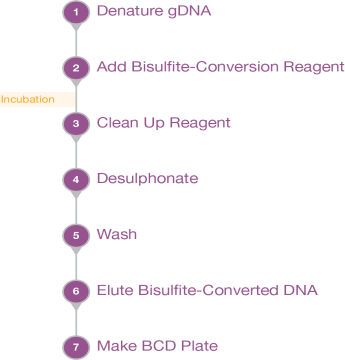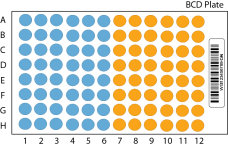Convert DNA
In this step, bisulfite converts genomic DNA samples using the Zymo EZ-96 DNA Methylation-Lightning MagPrep Kit. The bisulfite-converted genomic DNA (BCD) samples are then transferred to the BCD plate.
Make sure to follow the manufacturer instructions.
A minimum of 250 ng fresh DNA is supported for this reaction. Using more DNA, from 500 ng to 1000 ng, results in higher reproducibility.
 Consumables
Consumables
|
•
|
Zymo EZ-96 DNA Methylation-Lightning MagPrep Kit |
|
–
|
Manual catalog # D5046 (4x96 rxns) or D5047 (8x96 rxns) |
|
–
|
Automated catalog # D5049 (1x96 rxns) |
|
•
|
96-well 0.2 ml skirted microplate (1–3 plates) |
 About Reagents
About Reagents
|
•
|
Use a Zymo EZ DNA Methylation-Lightning MagPrep Kit (catalog # D5046, D5047, or D5049) for bisulfite conversion of genomic DNA (gDNA). For specifics, contact Illumina Technical Support. |
|
•
|
The conversion reagent is photosensitive. Minimize exposure to light. |
 Preparation
Preparation
Each bisulfite conversion process requires the following volumes:
|
1.
|
Prepare the conversion reagent according to the manufacturer instructions for immediate use. |
|
2.
|
Prepare the wash buffer according to the manufacturer instructions. |
|
3.
|
Apply a BCD barcode label to each new 96-well 0.2 ml skirted microplate. |
|
4.
|
If frozen, thaw BCD samples to room temperature and vortex to mix. |
Procedure
Use the instructions in the Zymo EZ DNA Methylation-Lightning Kit to do the following steps.
 Add Bisulfite-Conversion Reagent and Incubate
Add Bisulfite-Conversion Reagent and Incubate
|
1.
|
Add 130 µl Lightning Conversion Reagent to 20 µl DNA sample in a conversion plate. |
|
2.
|
Incubate in a thermal cycler using the following settings: |
|
3.
|
[Optional] Hold DNA at 4°C for up to 20 hours in the thermal cycler. |
 Clean Up Conversion Reagent
Clean Up Conversion Reagent
|
1.
|
Prepare the collection plate with the provided 600 µl M-binding buffer and 10 µl MagBinding beads. |
|
2.
|
Transfer and mix samples from the conversion plate to the collection plate. |
|
3.
|
Incubate the plate at room temperature for 5 minutes. |
|
4.
|
Transfer the plate to the magnetic stand. Wait 5 minutes. |
|
5.
|
Remove the supernatant to clean up the conversion reagent. |
|
6.
|
Remove the plate from the magnetic stand. |
|
7.
|
Add 400 µl M-Wash buffer and resuspend the beads. |
|
8.
|
Transfer the plate to the magnetic stand. Wait 3 minutes. |
|
9.
|
Remove the supernatant to clean up the M-Wash buffer. |
 Desulphonate Samples
Desulphonate Samples
|
1.
|
Desulphonate the samples with 200 µl L-desulphonation buffer. |
|
2.
|
Incubate at room temperature for 15–20 minutes. |
|
3.
|
Transfer the plate to the magnetic stand. Wait 3 minutes. |
|
4.
|
Remove the supernatant to clean up the L-desulphonation buffer. |
 Wash Plate
Wash Plate
|
1.
|
Add 400 µl M-Wash buffer and resuspend the beads. |
|
2.
|
Transfer the plate to the magnetic stand. Wait 3 minutes. |
|
3.
|
Remove the supernatant to clean up the M-Wash buffer. |
|
4.
|
Repeat steps 1–3 one time. |
|
5.
|
To dry the beads, transfer the plate to a heating element at 55°C for 20–30 minutes and remove residual M-wash buffer. |
 Elute Bisulfite-Converted DNA
Elute Bisulfite-Converted DNA
|
1.
|
Add 25 µl elution buffer directly to the dried beads and resuspend. |
|
2.
|
Heat the elution at 55°C for 4 minutes. |
|
3.
|
Transfer the plate to a magnetic stand for 1 minute or until the beads pellet. |
|
4.
|
Collect the supernatant and transfer it to a clean elution plate. |
 Create the BCD Plate
Create the BCD Plate
|
1.
|
Apply a BCD barcode label to a new 0.8 ml MIDI plate or a new 0.2 ml TCY plate. |
|
2.
|
Transfer the BCD to the plate. Use the volume appropriate for your plate: |
|
•
|
MIDI plate: 20 µl BCD sample to each well |
|
•
|
TCY plate: 10 µl BCD sample to each well |
The example illustrates 96 samples. For 48 samples, fill only the blue side of the plate.
SAFE STOPPING POINT
If you are stopping, heat seal the plate, and store at -25°C to -15°C for up to 30 days.


